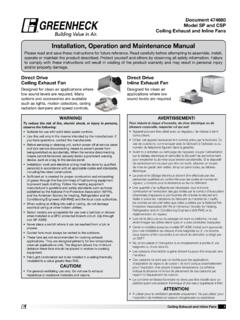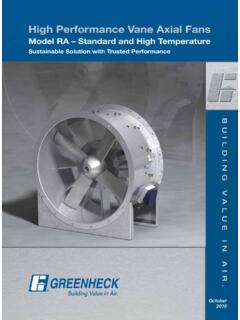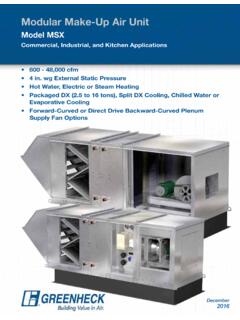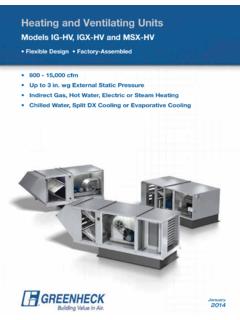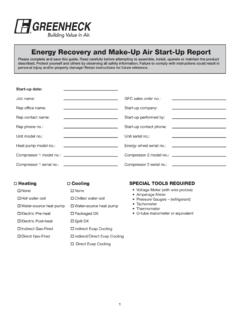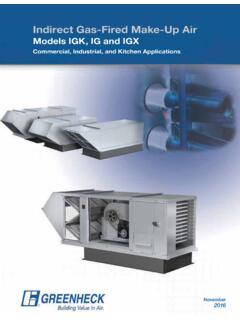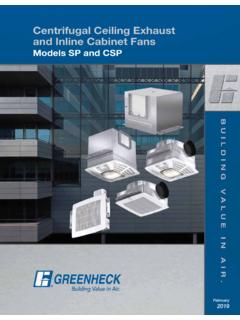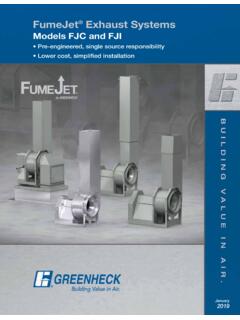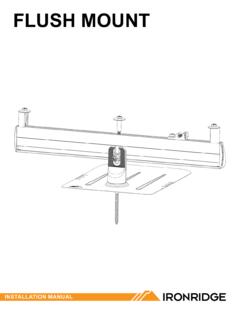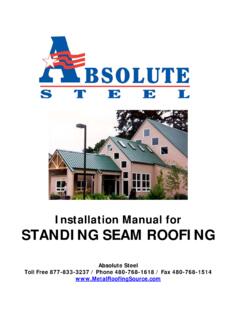Transcription of Installation Operation and Maintenance Manual - Greenheck …
1 Installation SupplementsRefer to the appropriate Greenheck Installation supplements for special requirements ( links are underline): IDHE-O Outdoor Applications T725 Thermostat Installation Instructions T725 Thermostat Operation Instructions T855 Thermostat Installation Instructions T855 Thermostat Operation Instructions Online version to this Installation instructions at instructions apply to zero clearance Installation of electric duct heaters within ducts. They are approved for use with heat pumps, air conditioners, or other forced air systems and may be controlled by contactors, relays, sequencers, or solid state duct heaters are pre-wired, factory tested, and furnished with integral and HandlingUpon receiving heater, check for both obvious and hidden damage. Check all insulators for breakage and inspect heater element wire(s) for any deformation or damage that could cause a short circuit to ground.
2 Make sure all fasteners are tight. Electrical connections such as pressure terminals should be checked for tightness. If damage is found, record all necessary information on the bill of lading and file a claim with the final carrier. Check to be sure that all parts of the shipment, including accessories, are accounted must be kept dry and clean. Indoor storage and protection from dirt, dust and the weather is highly recommended. Do not store at temperatures in excess of 100 F (38 C).This Manual is the property of the owner and is required for future Maintenance . Please leave it with the owner when the job is WarningImproper Installation , adjustment, alteration, service or Maintenance can cause property damage, injury or death. Read the Installation , operating, and Maintenance instructions thoroughly before installing or servicing this equipment.
3 UL Listed (see complete marking on product) ANSI/UL Standard 1996 (File E366239)IDHB and IDHE series are intended for Installation in accordance with electric heaters requirements established by:National Fire Protection Association NFPA Standards 90A and 90B NFPA Standard 70 General InformationTable of ContentsGeneral Information .. 1 Electrical Guidelines .. 2 Minimum Air Velocities..2-3 Installation .. 4-5 Insulated Duct Installation .. 6 Installation Details with SSR Controllers.. 7 Installation Details for Staged Heaters.. 8 Thermostat Connection Information.. 9-10 Troubleshooting Guide..11-12 IDHB and IDHE Duct Heaters Electric Duct Heaters1 Document 478052 IDHB and IDHEDuct HeatersInstallation, Operation and Maintenance ManualPlease read and save these instructions for future reference.
4 Read carefully before attempting to assemble, install, operate or maintain the product described. Protect yourself and others by observing all safety information. Failure to comply with these instructions will result in voiding of the product warranty and may result in personal injury and/or property RequirementsRefer to the wiring diagram on inside of cover. Make sure line and control voltage of system matches that noted on wiring in accordance with and any existing local codes. Check tightness of all factory and field electrical connections. Make sure fan interlock is wired in if the Duct Heater does not have an air flow 90 C (194 F) copper must be wired for Class 1 unless otherwise heater has integral transformer for control voltage to thermostat, use thermostat with isolating contacts to prevent interconnection of Class 2 all electrical power before servicing.
5 When servicing heater, make sure all components are repositioned in the proper location and reconnected per the wiring diagram. Replacement parts must be identical to the original components. Contact factory for replacement parts. Minimum Air VelocitiesThe minimum uniform airflow in a duct heater is directly related to the inlet air temperature. Consideration must be given to both airflow across the heater and inlet air temperature, (shown at right). 1. To calculate the watts per sq. ft. of duct area, divide the total watts required by the duct area. EXAMPLE: Duct Size = 2ft. x 3ft. Total watts = 20,000 W/Sq. Ft. = 20,000 = 3333 6 2. If the air handler equipment is expressed in fpm, then a direct cross reference can be made by comparing the temperature of the air (as it enters the Duct Heater) to the kW rating on the chart of rated velocity.
6 A. Draw a line horizontally from the Watts/Sq. Ft. required to the inlet air temperature being used. b. From this point of intersection on the Inlet Air Curve, draw a line down vertically to establish the air velocity. c. The velocity should never be lower than the velocity as determined from the chart. In cases where this is not true, the velocity must be increased or the kW required must be reduced. 3. In cases where the air handling equipment is expressed in CFM, convert to FPM by dividing the CFM by the duct area. EXAMPLE: FPM = CFM Duct Area1,4004,0006,0008,00010,00012,00014,0 0016,00018,00020,000 WATTS PER SQUARE FOOT, DUCT AREA22,000 Minimum Air Velocity (fpm)2,0001,2001,000800600400200 BELOW 78 F INLET AIR78 TO 90 F INLET AIR91 TO 110 F INLET AIRNote: Minimum airflow must be maintained at any point over the face of the heater.
7 The velocity of air should NEVER be lower than the specified minimum. In cases where this is not true the KW must be reduced or the velocity of air : Observe at least one complete heating cycle to insure that cycling of the safety limit controls does not occur before leaving the : Minimum Air VelocityElectric Duct Heaters2 IDHE: Air Flow Requirements Minimum Air Velocity: See charts below Maximum Inlet Air Temp: 110 F Maximum Heater KW: 30 KW per Square Foot of Duct Cross SectionElectric Duct Heaters3 InstallationFailure to follow instructions will void all warranties. For safe Operation and best performance, the following Installation procedures must be adhered : Do not Bank heaters (side by side). If greater capacity is required, proportion smaller heaters in separate runouts.
8 Heater control boxes must be completely accessible and located to provide ventilation at all OrientationHeaters may be installed in the vertical sides of horizontal or vertical ducts but never in the top or bottom of a horizontal duct. Heaters are approved for airflow in both directions when installed in horizontal : Heaters installed in vertical ducts are tested and approved for up airflow only!IDHE: Heaters installed in vertical ducts are tested and approved for up and down airflow. 1. Install heater a minimum of four feet: - From heat pumps or central air conditioner - Downstream from an air handler - From any canvas duct connector or transition in duct size - Downstream from an air filter - Upstream from a humidifier 2. At least 2 feet either side of an elbow or Cabinet OrientationIDHB: The control cabinet must be positioned as labeled on the : The control cabinet offset may be positioned in either direction as chosen by the installer.
9 Slip-in Heater: To install a slip-in heater (Figure 1), cut an opening as required in the side of the duct. Slide heater in the duct using the control box as template to mark the mounting screw holes. Remove unit and drill mounting holes. Mount unit to duct with sheet metal screws. Connect high and low voltage supplies along with fan interlock circuit (if no airflow switch is furnished). Larger heaters may require hangers. Connect high and low voltage supplies as required. Flange Heater: To install a flange type heater (Figure 2), insert heater between two sections of flanged duct, and bolt in place. For additional strength, the duct flange should be doubled as shown in the figure. Large heaters may require hanger straps. Connect high and low voltage supplies along with fan interlock circuit (if no airflow switch is furnished).
10 SLIP-IN HEATERFIGURE 1 FIGURE 2 FLANGE HEATERHEATINGELEMENTSTERMINAL ORCONTROL BOXWRAPPERWRAPPERTERMINAL ORCONTROL BOXHEATINGELEMENTS1"1"DOUBLELIPSLIP-IN HEATERFIGURE 1 FIGURE 2 FLANGE HEATERHEATINGELEMENTSTERMINAL ORCONTROL BOXWRAPPERWRAPPERTERMINAL ORCONTROL BOXHEATINGELEMENTS1"1"DOUBLELIPE lectric Duct Heaters4 Figure 3: IDHE orientationAirflow Switch: When furnished, ensure the airflow switch is plumbed appropriately for the given duct condition. The pickup tube must be connected to the switch port labeled LOW if the duct is negatively pressurized and the opposite port if positively : An airflow switch only proves that airflow exists (a differential in static pressure), not that the minimum air velocities and proper air distribution for the duct heater Duct Heaters5 Insulated Duct InstallationsDuct with External InsulationThe external insulation is to be removed from the area where the heater is : Size of heater is based on the duct size (no recess required).
